CHINA has nearly 5,000 years of recorded history. However, the history of Chinese furniture is even longer than that of its writing, which can be traced back to the Hemudu Culture more than 7,000 years ago, and it reached its peak in the Ming (1368-1644) and Qing (1644-1911) dynasties.
During the Ming and Qing dynasties, most of the furniture was hand-made using padauk, rosewood, and other high-quality hardwood as raw materials. Thanks to its sophisticated production process, elegant and simple style, graceful sculpting, precise and exquisite mortise-and-tenon structure, and smooth lines, its artistic charm is enduring, and it is still loved by people today.
Perfect Combination of Handwork and Wood
In ancient China, hierarchies were strict, and superiors and inferiors were obvious. People’s daily life, speech and behavior, and various customs and cultures were deeply marked by their feudalism rankings. As an essential part of daily life, Chinese-style furniture has not only been deeply influenced by feudal culture, but also reflects people’s daily life and cultural characteristics.
Chinese classical furniture represenative of the Ming and Qing dynasties used hardwoods such as rosewood and padauk. The common characteristics of these woods are hardness, corrosion-resistant, having distinct textures, and furniture made of them is beautiful and durable. These raw materials are now rare and expensive, and ordinary people often use wood such as pine, elm, and beech, but the quality between the woods differs greatly.
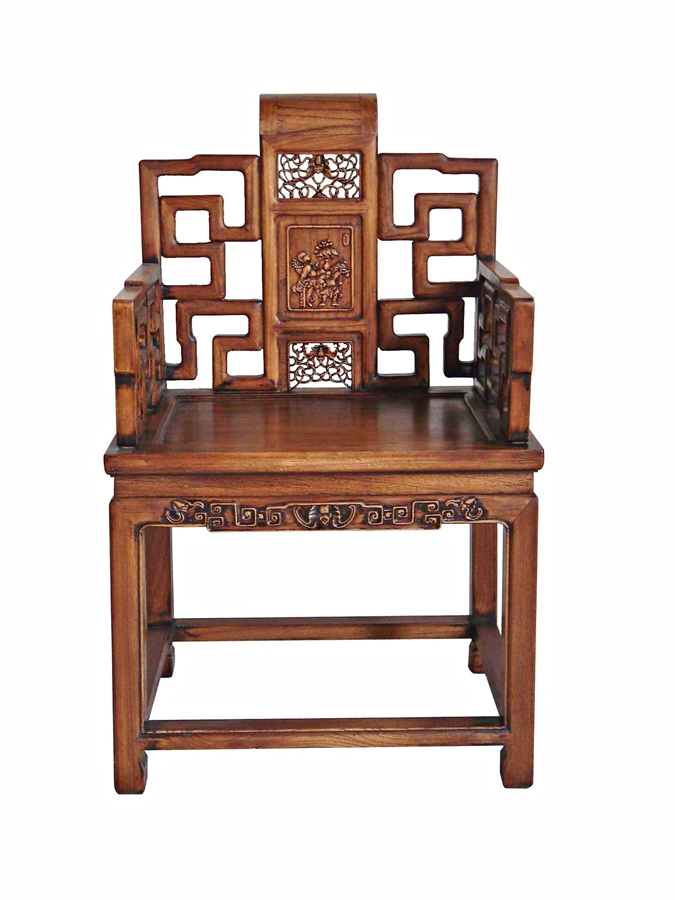
A Beijing-style chair. Its graceful and elegant design reflects rich imperial culture.
Classical furniture is mostly made by hand. Although with the advent of electric tools and the improvement of technology, some simple processes in furniture production can now be completed by machines. However, they cannot completely replace handwork. For example, the smooth hand feeling of the furniture surface requires the worker to use a sharp and wide knife to scrape along the wood surface after the machine has first flattened the wood, and use his hand to feel the change of smoothness through the touch after every scratching. Besides, furniture carving is also inseparable from manual operation. The shapes carved by the machine are neat but the lines are rigid and lacking vitality. Only the manual carvings are more refined and creative, dynamic and full of vitality.
The most exquisite aspect of Chinese classical furniture is the structural part of the furniture – mortise-and-tenon work.
Combining pieces of wood together using nothing more than the wood itself is a traditional carpenter’s craft in ancient China. It refers to the use of concave-convex splicing between two components. The protruding part is called the “tenon,” and the recessed part is called the “mortise.” When combined, fit them perfectly together. This method does not require nails and rarely uses glue, but solely relies on the tenon-and-mortise connection.
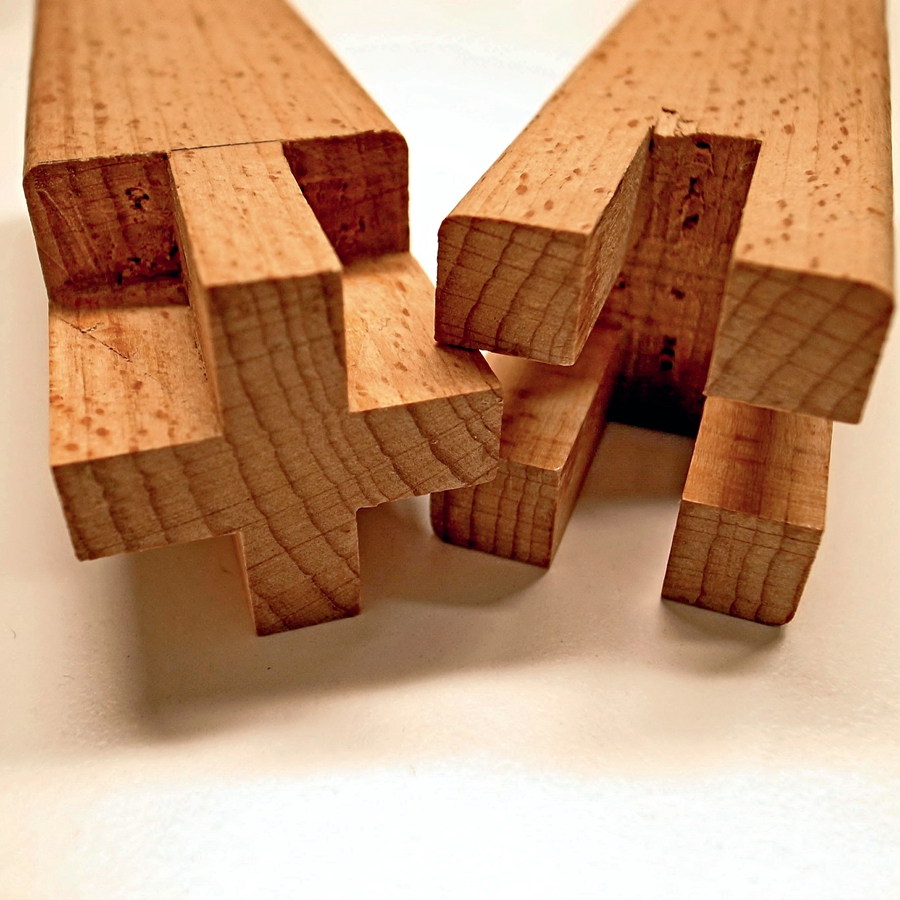
The tenon-and-mortise structure is the defining feature of Chinese classical furniture.
Tenon-and-mortise structure is the crystallization of the wisdom of the Chinese working people and fully embodies the creativity and artistry of humanity. It was first discovered in the stilt wooden structure where the ancestors of the Hemudu site lived more than 7,000 years ago. It was widely used in the Spring and Autumn (770-476 BC) and Warring States (475-221 BC) periods, became mature in the Song Dynasty (960-1279), and reached its peak in the Ming and Qing dynasties. Its greatest advantage is that it allows the wood to avoid damage by nails into the wood, and it is very stable and firm. The tenon-and-mortise technology is a basic skill of all carpenters. Due to the detailed and subtle combination of hardwood furniture, the tenon and mortise technology requires workers to be precise and compact, which can only rely on manual surveying and mapping. Therefore, it requires years to master the technology.
Chinese furniture also implies ancient Chinese philosophies. For example, Daoism emphasizes the equilibrium between yin and yang, while in the tenon-and-mortise connection, tenon is yang and mortise is yin, the two are integrated and complementary. Therefore, the entire device, irrespective of size, does not need a nail or a drop of glue, but it can still be firm for centuries regardless of temperature and climate changes. Confucianism, which emphasizes gentleness and moderation, has also been embodied in traditional Chinese funiture. Therefore, regardless of style or layout, Chinese furniture is mostly symmetrical. The type, shape, and material are the same or similar. With a sense of unity, harmony, and seriousness, it implies balance and stability.
Concise and Smooth Ming-style Furniture
Chinese furniture reached its peak in the Ming and Qing dynasties. Therefore, traditional Chinese furniture is divided into the Ming-style furniture and the Qing-style furniture. The distinction between the two is mainly based on the style, form, and craftsmanship of the work.
Jiangsu Province, especially the area adjacent to Suzhou, is well-known for the production techniques of Ming-style furniture. Therefore, it is acknowledged that furniture made in Suzhou is representative of the Ming-style furniture, also known as Suzhou-style furniture.
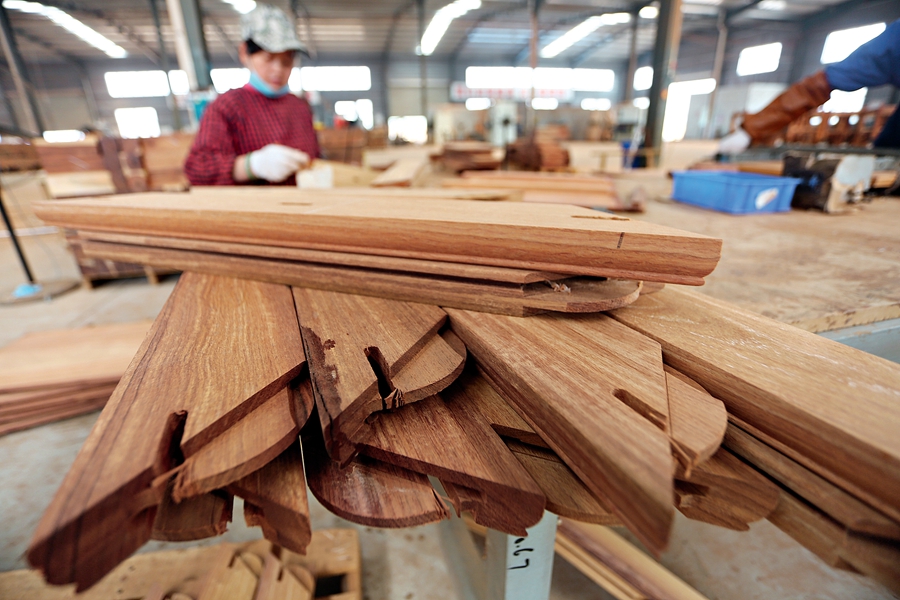
A craftsman busy crafting tenon-and-mortise pieces at a furniture manufacturer in Zaozhuang City, Shandong Province.
The Ming Dynasty was a golden era for the development of Chinese classical furniture. Perfect in shape and elegant in style, Ming-style furniture is unrivaled by those made in other eras. Its structure adopts small-structure splicing. The rationality and diversity of functions are emphasized in the styling. This is necessary to meet the physiological characteristics of human beings, and is rich and elegant, which is a combination of both art and practicality. The Ming-style furniture is dominated by rosewood, and it was changed to padauk during the late Ming and early Qing dynasties due to lack of rosewood. Ming-style furniture consists mostly of tables, chairs, and cabinets, which have no inlays and chasing, with very little carving decorations.
The designers of the Ming-style furniture are mostly refined scholars. Manufactured by excellent woodworking, it is full of cultural ambience. Designers often blend their creative ideas into the design, making it appealing, dignified, and simple. The structure stresses consistency of function and aesthetics, which is consistent with the pursuit of Chinese culture. At first glance, it seems insignificant, but upon further inspection, it shows a unique charm, and every detail is worth appreciating.
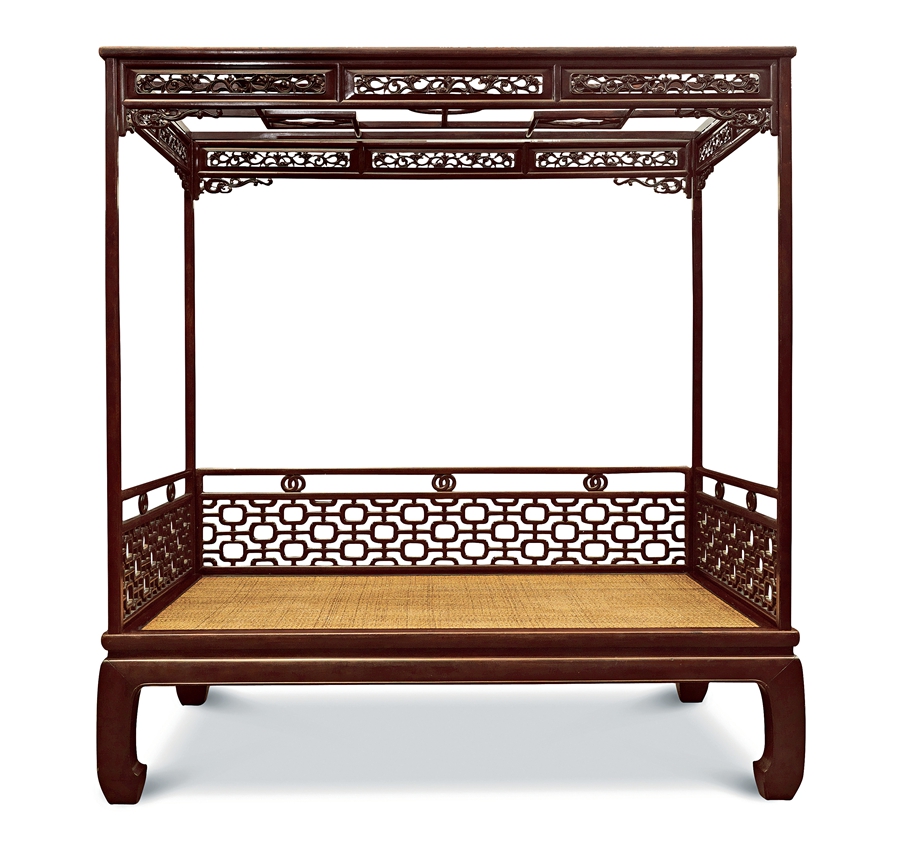
A Ming-style rosewood canopy bed.
The most prominent feature is the use of lines. Under the premise of satisfying the structure and function, the streamlined lines form the body. But it is not a single line, because if all are straight lines it appears dull and rigid, and if all are curves, it looks too weak. Therefore, the Ming-style furniture is a combination of lines of different types, and the curves and straight lines are properly matched to achieve both change and unity. Visual effects make people feel a natural elegance and a simple design concept, which is fully consistent with the modern fashion of minimalism.
The style gives full play to the charm of line art, and the use of lines is reflected in the linear change of the outline of various parts. For example, the backrest board of a chair mostly adopts an S-shaped curve, which fits the natural curve of the human body, and conforms to ergonomics. It is an extremely scientific curve. In general, the lines are the bones of the Ming-style furniture. The smooth and beautiful lines are just like the proportions of human skeletons. With a good foundation and appropriate modification, the beauty can last forever.
In 2006, the manufacturing techniques of the Ming-style furniture were included in the first batch of national intangible cultural heritage list.
Guangzhou-style Furniture
In the mid-Qing Dynasty, with further consolidation and strengthening of the Qing regime, the trend of the Manchu-Han confederation clearly manifested in the culture. The furniture art also continued to develop based on the highly successful achievements of the Ming dynasty. On the one hand, it innovated according to the interests of the ruling class. On the one other hand, Western missionaries came to China in large numbers to strengthen the exchange of Eastern and Western cultures. As such, many Western elements were integrated into Chinese furniture, so that the furniture system was integrated with certain Western elements and greatly enriched the form and function of Chinese furniture.
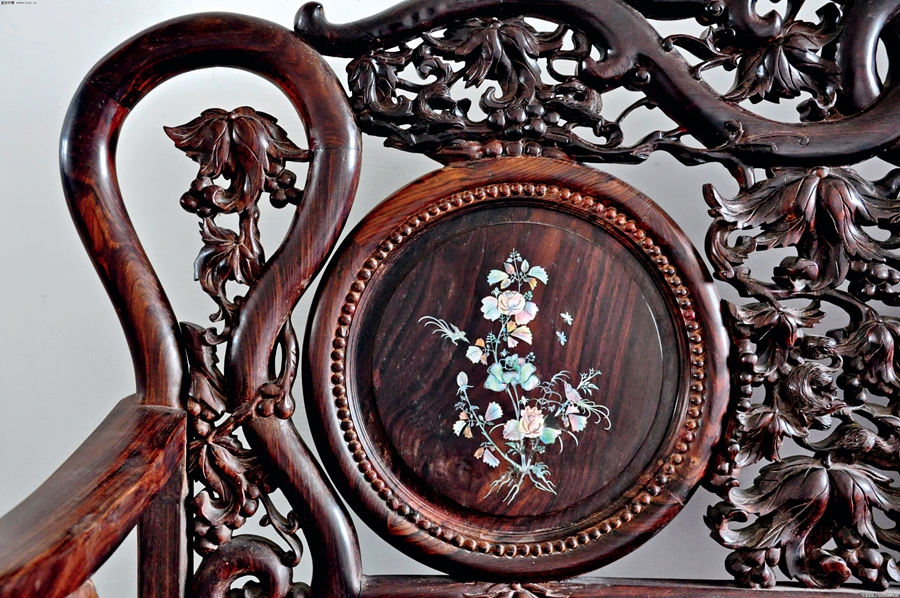
Guangzhou-style furniture pays attention to detail and decoration.
Guangzhou became an important gateway to China’s foreign trade and cultural exchanges due to its specific geographical location. The architectures of some local commercial institutions began to imitate Western styles and formed an unprecedented “Western fever.” The furniture that adapted to the buildings gradually formed a new style that is now in popular demand. As a result, the “Guangzhou-style” furniture which features big and heavy body and sophisticated carvings have become popular. A wide range of furniture manufacturing styles focus on complicated sculptural decoration. In addition to a large area of carving, different materials are inlaid, such as jade, marble, ceramics, and jewelry, of which the most prominent are marbles and shells.
Located in southern China, Guangzhou is rich in wood for furniture, which was a production area of traditional high-end furniture during the late Ming and early Qing dynasties. After becoming a trading port, the influx of Western culture attracted a lot of Baroque, Rococo, and other painting and architectural styles while taking into account the traditional beauty of design and the arts and crafts of Lingnan area. The furniture production has gradually changed from fresh and simple of the Ming Dynasty to a splendid luxury. In particular, the blazing Lingnan culture merges with the unrestrained Western art style, forming a unique Guangzhou style of furniture. The emergence of this new type of furniture, due to the high quality of materials, superb production processes, and extravagant style of materials, was deeply loved by the nobility. It quickly flourished in the middle and late Qing Dynasty and became one of the typical styles of Qing-style furniture.
Most of the materials used in Guangzhou-style furniture are precious hardwoods, which are characterized by bulky materials and steady modelling; they are lavishly decorated and use all the techniques that can make an aesthetic impact. For example, the main components of the furniture, such as the legs and pillars, no matter how large the bending is, generally do not use splicing methods. Instead, they are made out of one single timber. The entire piece of furniture also uses the same kind of wood, and it is not doped with other wood. In addition, the Guangzhou-style furniture pays attention to decoration. Except the back side of the furniture and the panels of tables and stools, all the other components are carved with sophisticated patterns. Although it is hand-carved and polished, it is finely ground, leaving the surface of the pattern glossy, without any signs of cutting. In the decorative theme and ornamentation, influenced by Western culture and arts, it is obvious that there are many Western patterns.
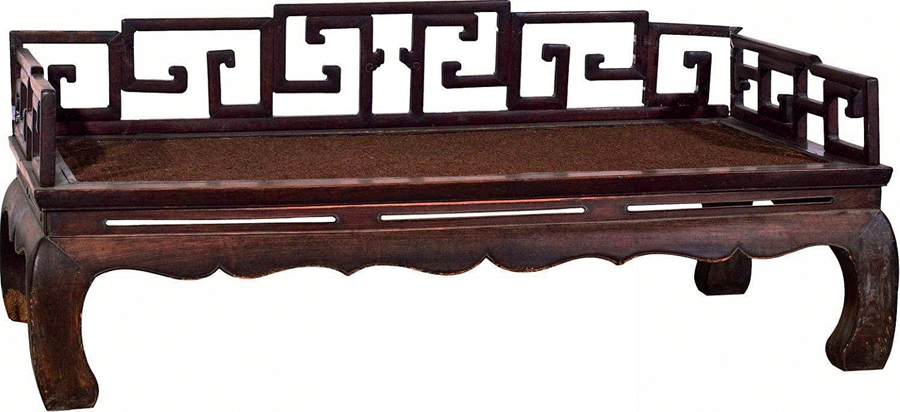
An exquisite piece of Suzhou-style furniture.
Its core values are embodied in the creativity of adapting foreign things for Chinese use and, making the past serve the present, and the courage to break through. This spirit of creativity and innovation is in line with the spirit of pioneering and enterprising of the Lingnan culture.
In 2008, Guangzhou-style hardwood furniture production techniques were included in the national intangible cultural heritage list.
Magnificent Beijing-style Furniture
The so-called Beijing-style furniture mainly refers to furniture that was used by the royal court, which were produced in Beijing. The manufacturing skills of this style were born in the imperial city, which is one of the three major schools of classical Chinese furniture.
The Beijing-style furniture was born in the Qing Dynasty. The emperor collected things from the world for his own use, and recruited skilled craftsmen from Suzhou and Guangzhou to enter the Imperial Workshop, a special agency for the manufacture of royal products. For the aristocracy of the Qing Dynasty, their aesthetic trend was broad-minded and noble. In order to meet the aesthetic taste of the rulers, the living environment of the imperial palaces and inner court, the furniture must have a grand style and posture. Thanks to sufficient financial resources, material resources, and manpower, a fine style of Beijing-style furniture was thus established, featuring magnificent, solemn, and graceful aristocratic temperament. This aesthetic effect not only retains the beauty of Suzhou-style furniture lines, but also draws on the gorgeous features of Guangzhou-style furniture. In addition, the literati and even the emperors personally participated in the design, gradually forming a graceful, elegant, and luxurious style that reflects the rich palace culture.
Beijing-style furniture also uses padauk, rosewood, and other precious hardwood materials. Before making a piece of furniture, the Imperial Workshop made a sample presentation, which could be produced after the approval of the emperor. Therefore, one of the characteristics of the Beijing-style furniture is the “royal style.” At the mid-Qing period coincides with prosperity, both the royal court and the high-ranking officials were in the pursuit of luxury in all aspects of life. The furniture specifications were more extravagent than the Ming style, the material also was bold, and the carving was more stable, luxurious, and beautiful. The surface of the furniture was decorated with gold, silver, jade, enamel, gold and copper plates, blue and white porcelain plates, and other special decorations, which formed a combination of luxury and craftsmanship.
One decorative characteristic is to integrate the Shang Dynasty’s bronzeware and the Han Dynasty’s stone carving art into the furniture carving decoration. This is the success of the Beijing-style furniture as well as its unique style. The images of Beijing-style dragons, phoenixes, and tigers are completely different from the Suzhou-style and Guangzhou-style decorations. These different forms of classical decoration are quiet, elegant, and antique. The furniture of the Yongzheng and Qianlong reigns preserved in today’s Imperial Palace in Beijing are mostly masterpieces of the Imperial Workshop. It maintains a high degree of coordination with the palace’s architecture, caisson ceilings, window ornaments, and the palace’s magnificent handicrafts. The furniture is in line with their environment.
However, due to excessive pursuit of luxury and decoration, it has reduced the furniture’s practicality. This is the biggest regret of the Beijing-style furniture. The Beijing-style furniture manufacturing technique reached its peak during the Kangxi and Qianlong reigns of the Qing Dynasty, and declined after the late Qing Dynasty. After the founding of the Pepole’s Republic of China in 1949, due to active rescue, protection, and support policies adopted by the government, the Beijing-style furniture production techniques have been restored and developed to a certain degree. While inheriting and retaining the charm and decoration of traditional Beijing-style furniture, it has reverted to practical use as its core development aspect. Nowadays, modern Beijing-style furniture has become an undisputed boutique.
In 2008, Beijing-style hardwood furniture production techniques were added to the national intangible cultural heritage list.
(Compiled by China Today)